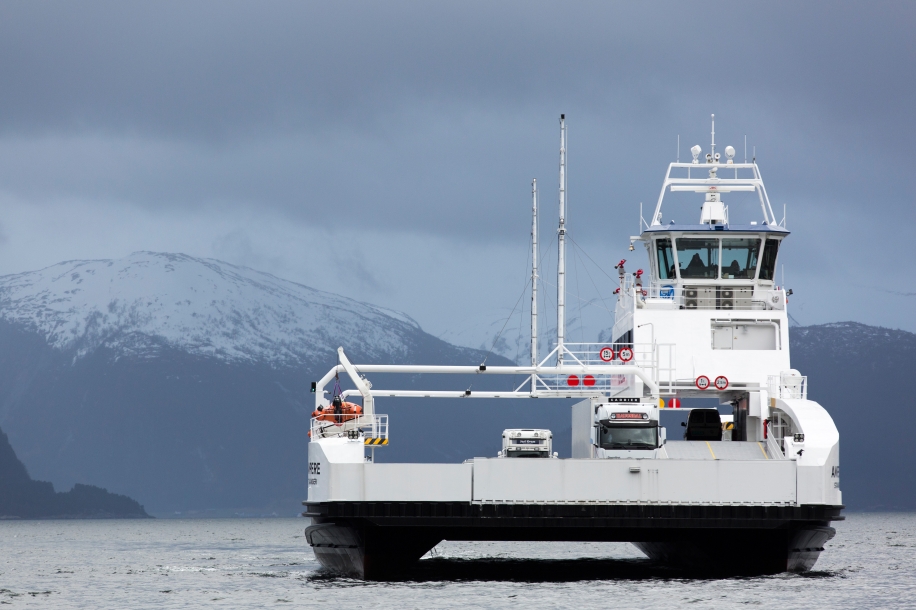The world’s first electric car and passenger ferry, Ampere, has been in service since May 2015. Ampere is powered by lithium-ion batteries and is owned and operated by the Norwegian company, Norled. Ampere covers the six kilometres across the Sognefjord between Lavik and Oppedal in 20 minutes, 34 times a day, 365 days a year. The stretch of water is part of the European highway E39, which is about 1.5 hours north of Bergen on the Norwegian midwest coast. The installation of the electric ferry, which is recharged by climate-friendly hydropower, is an important step in the transition to carbon-neutral transports.
A winning cooperation
Norway hosts a large number of ferries carrying passengers and vehicles across the country’s many grand fjords and lakes. Big, heavy and noisy, they often appear as disturbing misfits in the pristine and grandiose landscapes. The Ministry of Transport and Communications therefore launched a competition in 2010 to develop the most environmentally friendly ferry. The Ministry also announced that the winner would get to operate the Lavik–Oppedal route because the concession license of the then diesel-operated ships would expire in 2015. The electrotechnology company Siemens, with 165 years in the industry and active in more than 200 countries today, teamed up with the Norwegian shipyard Fjellstrand to produce an emissions-free ferry. In an interview, the Siemens Norway engineer Odd Moen explained that battery-driven propulsion had been used for submarines for more than a century, so why should it not be possible to “bring such a drive system concept to the surface?” (Siemens 2016).
The technical details
Ampere is an 80 by 20 metres car ferry that can take 120 vehicles and 360 passengers. The catamaran is quite substantial in size with an 11-ton battery, but it is only half the weight of a conventional ferry because it is made exclusively of aluminium instead of the normally used steel. Aluminium also means that the ship needs less maintenance, as the corrosion-resistant hull is better protected against rust and does not need any special coat of paint. Two electric engines with a combined output of 900 kW power the ferry. The lithium-ion batteries that fuel the engines have a total capacity of 1,000 kWh, which is equivalent to about 1,600 standard car batteries and has enough power to make a few return trips across the fjord. Siemens installed a 260 kWh battery at each dock to recharge the batteries on the ferry without causing temporary blackouts in the local villages where the ferry can recharge for the ten minutes it takes to unload and board passengers. The dock batteries can then slowly recharge from the medium-voltage grid before the ferry returns. Since the region’s electricity comes solely from hydropower, the ship runs on fossil-free energy that is cheaper than diesel. In comparison, a conventional ferry on this route would consume about 1 million litres of diesel and emit 2,680 tons of CO2 and 37 tons of NOX per year.
Where there’s a will, there’s a way
Ampere runs between two municipalities: Lavik in Høyanger municipality and Ytre Oppedal in Gulen municipality. Both are part of Sogn og Fjordane County. Installing a new type of transportation affects the local and regional infrastructure, which implies an ongoing dialogue and will to co-operate between the municipalities. The national Ministry of Transport and Communications launched the initiative and set a high environmental ambition. Because of the political will, open-mindedness, and motivation of stakeholders, an innovative, quiet and more sustainable entry won the tender.
Regional dimension
Replacing a conventional fossil-fuelled ferry with a clean tech ferry running on renewable energy brings Norway closer to achieving its national climate targets. Ampere can be the first ferry of many. Odd Moen at Siemens Norway believes that Norway can have battery-powered ferries running profitably on some 50 routes in the near future, especially as batteries become cheaper and more efficient every year. This would be a large step for Norway on its road to running on 100% renewable energy, if the nation decides to keep its oil in the ground (Siemens 2016).
Learn more…
